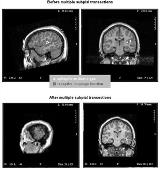IS LINGUISTIC FUNCTION STILL THERE AFTER MULTIPLE SUBPIAL TRANSECTIONS OVER WERNICKE[apos]S AREA?
Abstract number :
2.319
Submission category :
Year :
2004
Submission ID :
4768
Source :
www.aesnet.org
Presentation date :
12/2/2004 12:00:00 AM
Published date :
Dec 1, 2004, 06:00 AM
Authors :
1Eduardo M. Castillo, 1Joshua I. Breier, 2James W. Wheless, 3James E. Baumgartner, 1Ekaterina Pataraia, and 1Andrew C. Papanicolaou
Multiple subpial transection (MST) is the procedure of choice when the affected brain area includes regions known or expected to mediate a sensory, motor, or higher cognitive function. In such cases MST minimizes the risk of morbidity when compared to other, more aggressive, surgical procedures. The fact that functional outcome after MST in language-specific cortex has been reported to be positive (although some transient deficits are in some cases evident) has been used to support the concept that the cortical representation of the underlying function is not altered. The truth is that little is known about the changes in the representation of function that MST can trigger. In this report we describe the pre- and post-operative maps of receptive language activation obtained using an externally validated MEG procedure in a patient diagnosed with the Landau-Kleffner syndrome. Seizure control was achieved with MST over the left temporo-parietal junction. The linguistic deficits present pre-surgically worsened for approximately 6 months following MST. Three years later, the patient was re-evaluated. His linguistic skills, especially those involving receptive language functions, were found, at that time, to have improved beyond their pre-surgically levels. When compared, the MEG-derived maps of receptive language were similar pre- and post-surgically, showing the [ldquo]typical[rdquo] profile of activation involving the posterior superior temporal gyrus of the left hemisphere (the area where the MTS was carried out).[figure1] In this case, the spatial overlap between pre- and post-surgical MEG-derived maps suggest that the cortical substrates of receptive language function are not reorganized after MST even in those cases were an initial transient linguistic regression is present. (Supported by NINDS grant (NS 37941) to Andrew C. Papanicolaou.)
